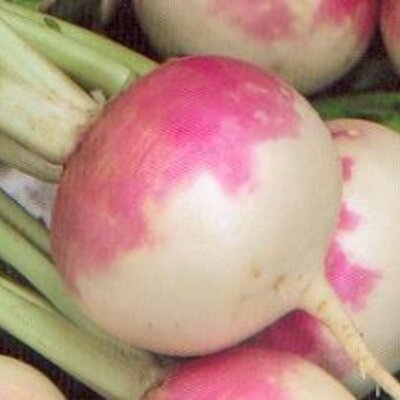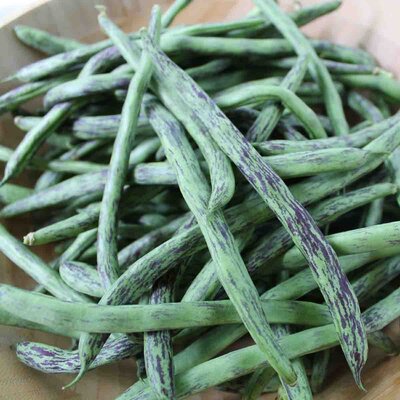
Nancy à Collet Rose - Turnip
The round roots of this old variety are white with a pink collar and a fine taproot. Their firm flesh offers an appreciated flavor. Autumn harvests can be kept until March or April.
Characteristics of the De Nancy à Collet Rose turnip
The De Nancy à Collet Rose turnip, Brassica rapa, is an ancient variety of root vegetable native to eastern France. It was mentioned in Vilmorin-Andrieux's 1885 book Les Plantes Potagères. Its round roots, 10 to 12 cm in diameter, are white with a violet-pink collar. Its firm flesh can be eaten raw or cooked. This early, hardy variety is resistant to cold and has excellent shelf life. Plants grow up to 30 cm high.
How to grow the De Nancy turnip
Sow outdoors from March to September, for harvesting from May to November.
Sow directly in the vegetable garden, after the last frosts, in rows 25-30 cm apart. Cover the seeds lightly, press them down and keep them moist until they emerge. Seeds generally germinate in 5 days, at temperatures between 15 and 20°C. Thin to 10 cm when plants have 5-6 leaves.
Turnips like sunny spots and rich, cool soil. Like all root vegetables, it fears drought, which makes its roots fibrous. Regular watering is therefore recommended.
Turnip companion plants
Certain plants, such as fennel, repel turnip pests. Lettuce, tomatoes, peas, carrots and mint are also recommended. However, as with most Brassicaceae, it's best to keep turnips away from garlic.
Harvesting and storing De Nancy turnips
This early variety is harvested from May to November, around 2 months after sowing.
De Nancy turnips are more suited to autumn and winter harvests, but can also be sown in spring for earlier harvests.
For winter storage, harvest turnip Jaune Boule d'Or before the first frosts, from September to November. After drying for a few days, removing the tops and wiping dry, the selected roots are buried in a sheltered place, such as a cellar or silo, in sand or sawdust. They will then keep for 2 to 4 months.
Turnips can also be left in the ground in the vegetable garden, protected from frost with a good mulch.
Like white cabbage, turnips can also be preserved finely sliced and pickled in jars to make "turnip sauerkraut".
The benefits of turnips
Turnips, which are rich in fiber and generally contain almost 90% water, help keep the intestines moving smoothly. It is widely known for its emollient and soothing properties. It is also sometimes used to treat chest illnesses. Rich in vitamins (including vitamin C and vitamin B) and trace elements (notably iron, zinc and copper), turnips can be included in the diets of convalescents, the weak and anemic, and athletes.
In the kitchen, turnips can be eaten raw, grated into salads, or cooked in the oven, frying pan, saucepan or pressure cooker. It's the perfect accompaniment to meats, soups, mushrooms and fruiting vegetables.
These products may also be of interest to you
in the ground
Sow lightly, directly in place, after the last frosts, in rows 25-30 cm apart. Cover seeds lightly, press down and keep soil cool. Thin to 10 cm when plants have 5 to 6 leaves.
Turnips do not appreciate dryness, which makes their roots fibrous. Regular watering is therefore recommended. Roots kept for the winter should be harvested before the first frost and stored in a cellar. They can also be left in the garden, protected from frost, but beware of pests.
July, August, September
September, October, November, December
in the ground
semi-shade, sunny
medium
humus
fees, wet, rich
Brassica rapa
early
From 800 to 1000 g
500 seeds
round
farm
Pink, White
From 60 to 100 cm
From 10 to 20 cm
France
1885
"Vilmorin-Andrieux "Les Plantes Potagères
This ancient variety originated in eastern France. It is mentioned in Vilmorin-Andrieux's 1885 book "Les Plantes Potagères".
Turnips are rich in fiber and contain almost 90% water, which helps keep intestinal transit moving smoothly. It is popularly known for its emollient and soothing properties. It is also sometimes used to treat chest illnesses. Rich in vitamins (including vitamin C and vitamin B) and trace elements (notably iron, zinc and copper), turnips can be included in the diets of convalescents, the weak and anemic, and athletes.











